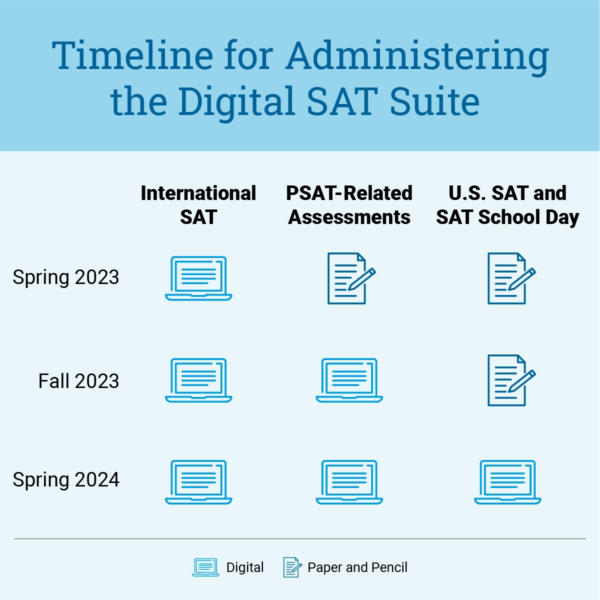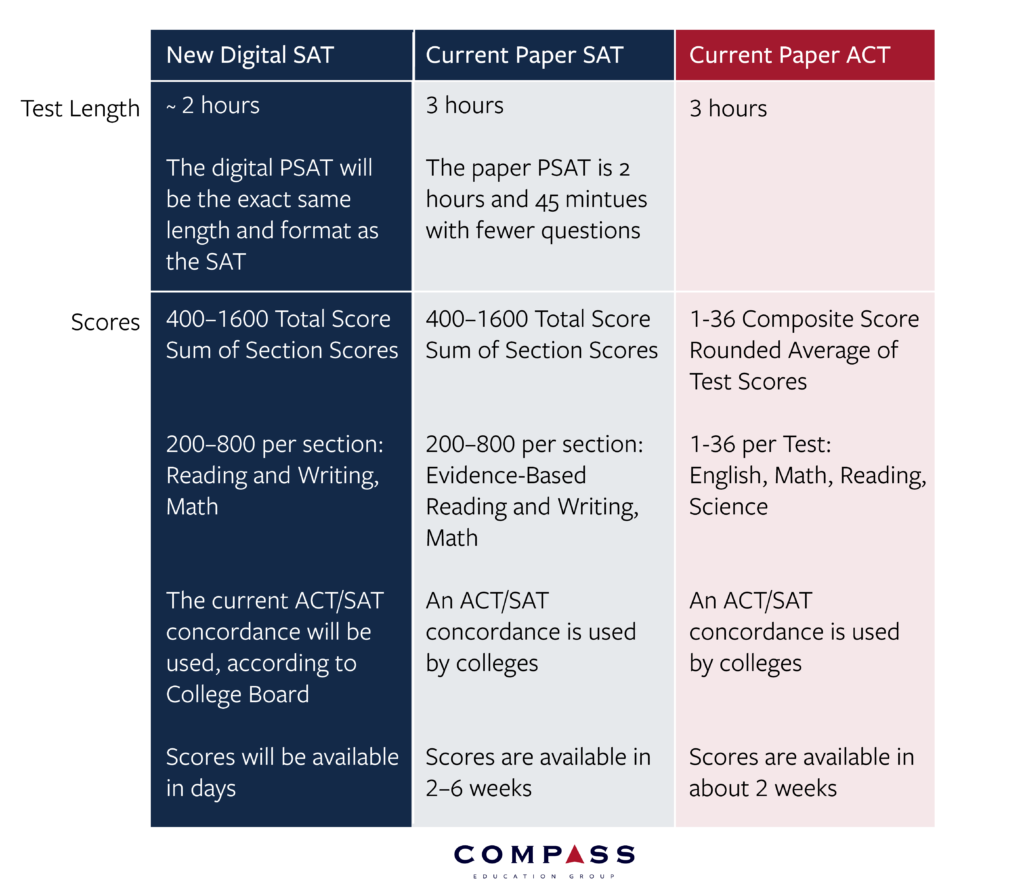per an article in the Raleigh News and Observer which dropped today, the same day that (maybe? likely? certainly?) EA decisions are going to be released. Most of these additional spots will go to in-state applicants (the out-of-state cap still stands). Further, 500 more enrolled means more than 500 additional applicants admitted (average admitted to enrolled yield sub-50% overall BUT over 60% for in-state applicants in 2024).
U Miami Will Require An ACT/SAT Result From Fall 2026 Applicants
A surprising decision (in my opinion), their press release can be found here.
Breakdown of New ACT – Format and Timing
From the good folks at Applerouth: The Enhanced ACT Explained: Changes, Challenges, and Expert Tips
An interesting year for the Class of 2026, to be sure. So many of my clients take one final ACT in September of their senior year and thus will take this “enhanced” ACT regardless of whether testing on paper or digitally. School day testing in NC this February will still require students to take the science section (often a student’s second test) and will likely be on paper.
Students and families are rightly curious what this all means from a scoring perspective. From the article: “The new test will also continue to be scored on a 1-36 scale, and scores are considered to be vertically aligned with the old test (i.e. if you take the newer test, your composite score should be the same or very close to what you would have scored on the older version of the test, provided you took the tests on the same day).”
I’m going to have to get used to adding three sections and dividing by three to determine superscores (now rounding up at .66, down at .33)!
New ACT Coming (but it’s going to take a bit)
Optional science section for online test takers beginning in 2025. Optional science section for school-day testing in 2026 (of note for current NC rising sophomores who will test at school in Feb/March 2026). If students elect to not take the science section, the ACT will take them approximately 2 hours. What about those who take the ACT on paper? Not sure in 2025, but my sense is the paper test is going to go away. How will colleges react? I predict that they won’t care much at all …
A good summary of the changes can be found here.
UNC System Remains Test Optional (for most) Fall 2025 and Beyond
UNC Chapel Hill’s full statement can be found here. Of note (directly from their post):
- For students applying for the 2025-2026 academic year, students with a weighted GPA of 2.8 or above (on a 4.0 scale) are not required to submit a test score. Students with a weighted GPA below 2.8 (on a 4.0 scale) are required to submit either an ACT or SAT score.
- For students applying for the 2026-2027 academic year and beyond, students with a weighted GPA of 2.8 or above (on a 4.0 scale) are not required to submit a test score. Students with a weighted GPA below 2.8 (on a 4.0 scale) are required to submit either an ACT score of 17 or higher or an SAT score of 930 or higher.
NC State has yet to update its test score consideration page, but my hunch is they will not go above the requirement outlined above.
Waiting on UNC System (again) and an interesting article by Jeff Selingo
I don’t even need to describe what Selingo’s article is about – just read the title! Inside The Craziest College-Admissions Season
Still waiting on the UNC system to announce their 2025-26 test policy. Same goes for U South Carolina and Clemson. Smoke signals from UNC system board meetings suggest there might be a GPA cutoff, meaning students with certain GPAs and higher may be allowed to continue to apply test-optional. We shall see.
Infrequent blogger indeed – I’m lucky to stay busy working with a great group of students! Questions? Never hesitate to reach out!
UNC System Schools Test Optional For Fall 2024 Applicants
So says the UNC Board of Governors – The University of North Carolina System statement on test optional
And because I get asked this all of the time, YES, this includes NC State!
For The Class Of 2025 And Beyond – More Information On The New Digital SAT (and PSAT!)
Perhaps it’s a touch unfair, as I truly do like all of the students that I work with, but the Class of 2025 holds a special place in my heart as it’s the class of my youngest! She and her classmates will be a part of the inaugural class of students who will take the PSAT on computers in October 2023 and then SATs on computers January 2024 and beyond.
Want to read an easy to understand guide on how this digital SAT will work? Check out this terrific post and accompanying charts by Art Sawyer at Compass Education Group.


What An Ivy Says To School Counselors Before It Releases RD Decisions
I am going to leave this email that Brown recently sent to school counselors without comment other than to say two things: 1) Brown has of late sought to enroll ~1700-1800 first year students per year. If that is their enrollment target this year then they will have enrolled at or just over half of their class through their binding early decision plan. 2) Yes, this email is from Brown, but you could substitute the name of any other Ivy League school (or MIT, or Stanford, or Northwestern, or Vanderbilt, or … you get my point) and the numbers would be similar. Highly rejective indeed.
The email:
I am writing to share that Regular Decision admission decisions will be posted Thursday, March 31 at 7:00 p.m. Eastern Time and can be viewed by students through the Brown Applicant Portal. Applicants received an email on March 23 with a link to the portal outlining the date and time that decisions will be available.
Brown received 50,649 applications for the Class of 2026, a nine percent increase over last year that makes this the largest application pool in the University’s history. Brown will make 1,651 Regular Decision offers of admission to the incoming Class of 2026, in addition to the 895 Early Decision admission offers made in December. The overall admit rate for this year’s pool is 5 percent, with a Regular Decision admit rate of 3.6 percent.
Additionally, 17 percent of accepted students represent the first generation in their family to attend college. This year’s admitted class comes from 91 nations, all 50 U.S. states, the District of Columbia and Puerto Rico. The top countries represented outside the United States are China, the United Kingdom, Canada, India, Singapore and Ukraine.
Of the 3,827 applicants to the Program in Liberal Medical Education (PLME), 84 students were admitted with a 2 percent admission rate. Of the 838 applicants to the Brown-RISD Dual Degree Program, 19 students were admitted with a 2 percent admission rate.
If spaces in our entering class are available after our May 2 reply date, we will be pleased to make additional admission offers to students on our waitlist. Please note, however, that all spaces in the Program in Liberal Medical Education have been filled. The number of students admitted from the waitlist will depend on how many students accept our initial admission offers by May 2. In recent years, the number of waitlist spaces available in our incoming class has ranged from 30 to 180. Waitlist activity will conclude by mid-summer, and more information on the waitlist is available here.
Good luck to your students as they await their decisions.
Major Changes To SAT Will Impact High School Class of 2025 And Beyond
Hot off the presses this morning is an announcement by the College Board that, beginning in 2024, the SAT will be offered digitally only and will be a shorter, adaptive exam. No more bubble sheets and No. 2 pencils. The test itself may be as short as two hours long. Students will still have to take the exam at a testing location but may do so on their own computers or ones issued by the school. Finally, and perhaps most confusingly, the test will be “adaptive,” meaning that the questions asked will vary based on student performance as they take the exam.
I’ve noted before my belief that the people at Compass Education Group are among the best at helping make sense of all things SAT and ACT – I encourage you to read their initial analysis here.
The College Board indicates that digital exams will be offered beginning in 2024 but that it will offer the PSAT/NMSQT – the PSAT that almost all juniors are required to take at the majority of public and private schools in the United States – in October of 2023 digitally as well. This will take place in the fall of the junior year for students in the class of 2025 (current high school freshmen). Interestingly, high achieving students in this class often take their first SATs in the fall of their junior year which would be on paper in 2023. The first digitally offered SAT is slated to be offered on the March 2024 test date (the March date is a HUGELY popular test date for high school juniors).
Curious about other options? At this time, the ACT is offered digitally through participating schools only and is taken in exactly the same format as offered on paper (non-adaptive).
A huge question for many will be how do you prepare for this new online SAT? Khan Academy currently offers free online tutoring options and I imagine their product will become even more popular. Tutoring services will certainly be scrambling initially, however.
A more subtle question – how will this new digital SAT be compared against the ACT? Will concordance tables need to be re-centered? Stay tuned.
Finally, and perhaps most importantly, I (yes, this is opinion!) do not believe that this will have any impact on the test-optional movement sweeping college admissions. Just last week, the University of Iowa system joined the growing number of colleges and universities in expanding its test-optional policies. Test-optional is here to stay, though changes to current policies at popular local university systems (North Carolina, South Carolina, and Tennessee) have yet to be announced for the 2022-2023 application cycle. However, no piece of your high school record will ever be as important as your transcript (and it’s not really close). So freshmen, for now, keep your head down and continue to work hard in the classroom!
